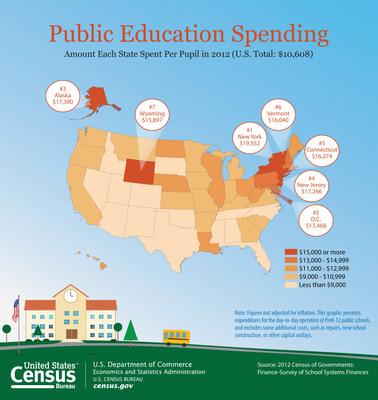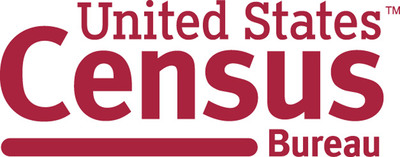WASHINGTON, May 22, 2014 /PRNewswire-USNewswire/ -- Public elementary and secondary education revenue declined in fiscal year 2012 for the first time since 1977, when the U.S. Census Bureau began collecting public education finance data on an annual basis. According to new Census Bureau findings released today, public elementary and secondary school systems received $594.5 billion in total revenue in fiscal year 2012, down $4.9 billion (0.8 percent) from fiscal year 2011.

Today's findings come from Public Education Finances: 2012. These statistics provide figures on revenues, expenditures, debt and assets (cash and security holdings) of the nation's elementary and secondary public school systems. The report, released annually, includes detailed statistics on spending - such as instruction, student transportation, salaries and employee benefits - at the national, state and school district levels.
State governments were the leading source of revenue ($270.4 billion), closely followed by revenue from local sources ($264.6 billion); almost two-thirds (65.3 percent) of revenue from local sources came from property taxes. Public school systems received $59.5 billion in revenue from the federal government, a decrease of $14.2 billion (19.2 percent) from the previous fiscal year.
The 50 states and the District of Columbia spent $10,608 per student on public elementary and secondary education in 2012, the same amount as 2011. All nine states in the Northeast were ranked among the 15 states with the highest spending per pupil (not including capital outlay or expenditure on long-term debt) in 2012. Out of the 20 states with the lowest spending per pupil, 18 were in the South or West.
The top spenders per pupil were New York ($19,552), the District of Columbia ($17,468), Alaska ($17,390), New Jersey ($17,266) and Connecticut ($16,274).
For the third year in a row there was a decline in total expenditures, which decreased to $593.8 billion, a $2.5 billion (0.4 percent) decrease from the previous year.
For the first time, these statistics can be found in American FactFinder, one of the Census Bureau's data research tools.
Other highlights:
- Of the 100 largest school systems by enrollment in the U.S., the following had the highest spending per pupil in FY 2012: New York City School District ($20,226), Boston City Schools ($19,720), Baltimore City Schools ($15,287), Anchorage School District in Alaska ($14,963), Montgomery County Schools in Maryland ($14,873) and Howard County Schools in Maryland ($14,747).
- Of the 100 largest school systems by enrollment, six of the top 14 with the highest spending per pupil in 2012 were in Maryland.
- Of the $593.8 billion in total expenditure for public school systems, $524.0 billion is comprised of spending for day-to-day operation of schools and school districts. Expenditure for instruction amounted to $316.6 billion (53.3 percent) of total spending, while expenditure for support services amounted to $179.8 billion (30.3 percent).
- Instructional salaries, the largest expenditure category for public elementary and secondary education, totaled $206.7 billion in 2012 (34.8 percent of total spending).
- The states spending the least per pupil in 2012 were Utah ($6,206), Idaho ($6,659), Oklahoma ($7,466), Arizona ($7,559) and Mississippi ($8,164).
- Debt for public elementary and secondary school systems decreased by 0.1 percent from $407.0 billion in 2011 to $406.5 billion in 2012.
- States that had the highest percentage of their total public school system revenue coming from federal funding (of the statewide education revenue) were Louisiana (18.1 percent), Mississippi (17.8 percent), South Dakota (16.4 percent), Alaska (14.8 percent) and North Carolina (14.3 percent).
- Conversely, states that had the lowest percentage of their total school revenue coming from federal funding were New Jersey (5.2 percent), Connecticut (5.2 percent), Maryland (6.3 percent), Massachusetts (6.3 percent), and New York (6.4 percent).
The data used in the tabulations came from a census of all 15,171 public school systems. As such, they are not subject to sampling error. Although quality assurance methods were applied to all phases of data collection and processing, the data are subject to nonsampling error, including errors of response and miscoding. For more information, visit the Census Bureau's website at http://www.census.gov/govs/school/.
Rosa Rendon
Public Information Office
301-763-3030
email: pio@census.gov
CB14-95
Graphic | JPG | PDF
Infographic
Blog

Photo - http://photos.prnewswire.com/prnh/20140522/90641
Logo - http://photos.prnewswire.com/prnh/20110428/DC91889LOGO
SOURCE U.S. Census Bureau

